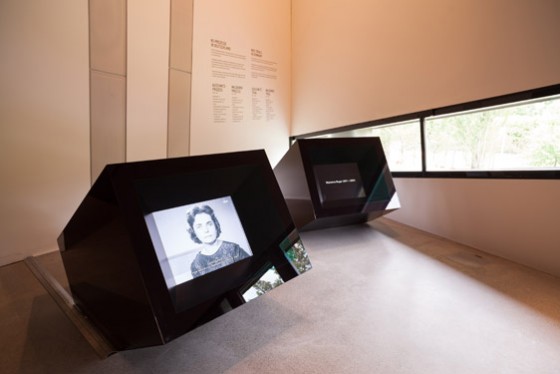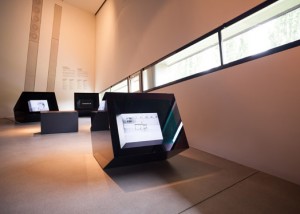A New Space for the Auschwitz Trial in the Permanent Exhibition
Last October I wrote a blog post about Memorandum, a Canadian documentary film about the Auschwitz trial in Frankfurt (1963 – 1965). An excerpt of this film has been part of our permanent exhibition for a number of years already. We observed that the film clip elicited a much more intense response from visitors to the legal proceedings of Nazi criminals in Frankfurt than did other forms of media, such as photographs or audio clips. For this reason, documentary film material has been made the central focus of the newly designed area of our permanent exhibition.

“My husband was very accurate, indeed, but […] I can’t imagine all this,” said the wife of Auschwitz perpetrator Wilhelm Boger to NDR journalists
© Jewish Museum Berlin, photo: Alexander Zuckrow
Just a few days ago we re-opened this space with the title “On trial: Auschwitz/Majdanek.” In order to convey how the Auschwitz trial in Frankfurt shaped and changed public attitudes towards the past in Germany, we now show a variety of excerpts from contemporary television coverage. In the international coverage of the trial, groundbreaking questions were raised about the way the National Socialist era was officially and publicly dealt with. The first Auschwitz trial in Frankfurt lasted for 20 months and was widely discussed in the papers, on the radio, and on television. More than ever before the media reported on the systematic mass murder in the camps, and on the perpetrators who eagerly carried it out or cooperated with it. Testimony given by survivors – 211 concentration camp prisoners spoke at the Auschwitz trial – also reached the public. Frankfurter Allgemeine Zeitung reporter Bernd Naumann, who followed the ongoing trial, described the proceedings on Dutch television:
“Anyone not made of stone has been changed by the way the past has stood up before us once again. (…) This lethal machinery, the accomplishment with which this [the murder] was carried out. (…) This was never as clear as during this Auschwitz trial.”
In addition to this interview and other clips, we also show a program from the Hessian broadcasting network with the very 60s-sounding name “Heute Abend Kellerklub” (“This Evening Cellar Club”). In it, the Hessian attorney general and initiator of the Auschwitz trial, Fritz Bauer, explains to an audience of young adults what he is essentially blaming the accused for: their inability to say “no.” Bauer saw the opportunity, with the Auschwitz trial, to teach the public – particularly the younger generation – about the time of National Socialism. Other incisive segments of his talk can be seen on the Hessian Broadcasting website.

The monitor cubes were designed by Holzer Kobler Architekturen, the video installation was realized by TheGreenEyl
© Jewish Museum Berlin, photo: Alexander Zuckrow
In total, we chose 18 sequences from Canadian, Dutch, and West-German productions to be presented in an extensive 30-minute installation on three monitors. The videos light up in shining black monitor cubes in a specific, deliberate succession. Short texts use keywords from the film clips to explain who is speaking and historically contextualize the material. This installation opens with a two-minute segment from Günter Gaus’s legendary television interview with Hannah Arendt, in which she says: “Something happened there that none of us can come to terms with.” The interview can be watched in full length on YouTube:
The television excerpts in the newly designed area of our permanent exhibition are not merely a way to show visitors what happened during the Auschwitz trial. They are meant to demonstrate how the trial and its reception in the media launched a re-examination of Germany’s National-Socialist past, a process that is still underway today.
Monika Flores Martínez, Permanent Exhibition